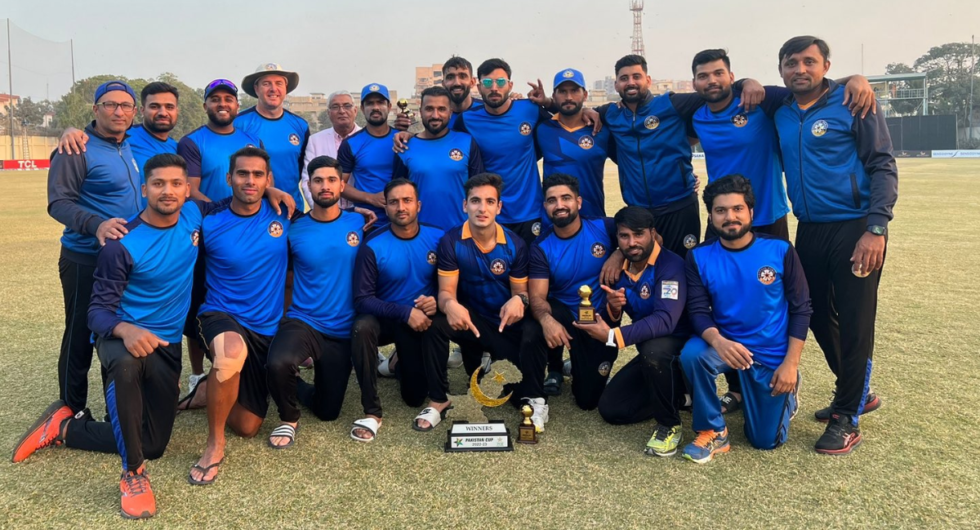The Karachi connection: How a group of English coaches conquered Pakistan’s domestic scene

 by Ben Gardner
by Ben Gardner
@Ben_Wisden 5 minute read
Paul Franks and Paul Nixon talk to Ben Gardner about their experiences coaching in Pakistan domestic cricket this winter.
It’s December 18, the dead of winter in the UK, but the Pakistan Cup fixture being played out in Karachi between Sindh and Central Punjab has a decidedly English feel.
It’s not just the New England run rates – Sindh put up 347-8, a target chased down with more than four overs to spare – but the faces in the dug outs too. Sindh are being coached by Leicestershire’s Paul Nixon, while overseeing Central Punjab is Paul Franks, Nottinghamshire assistant coach.
Franks and Nixon were both in Pakistan as part of a scheme put in place last summer by the Pakistan Cricket Board, who identified select English coaches to take charge of two of the six regional teams after the county season ended. Results were positive, with Central Punjab claiming the Pakistan Cup title, and Sindh unbeaten in the Quaid-e-Azam Trophy until the final, when, deprived of their international stars, they ran into the prodigious Muhammad Hurraira, whose double-century gave Northern glory.
Their success is a worthy reminder of the stature of English coaches on the global stage when opportunities to prove themselves at the next level can be hard to come by. Much has been made of the lack of home representation atop the dressing rooms in The Hundred, and as for the ECB, there are occasional chances to show mettle with the Lions, but anything more permanent is on a one-out, one-in basis. “You don’t often get the chance to be a head coach when you’re still working as an assistant coach,” says Franks, who heard about the job while serving under Andy Flower at Trent Rockets in The Hundred.
For Nixon, heading into his sixth season in charge of Leicestershire, there are other motivations.
“I’ve always got my Leicestershire hat on, always,” he laughs, when asked if there are any players he might consider trying to bring over to county cricket. “That was part of the remit as well. There might be some exciting news coming out in the next few weeks.” Sindh’s players include Sarfaraz Ahmed, Saud Shakeel and Abrar Ahmed. Foxes fans, keep your eyes peeled.
***
Neither Franks nor Nixon had to take on their assignments alone. For Nixon, Ian Fisher, formerly on the strength and conditioning team at Yorkshire, was key in arriving before the end of the English summer and scoping what needed to be done, with Neil Johnson, a former Zimbabwe international who now coaches at Oakham School, also involved. For Franks, meanwhile, Bilal Shafayat, an assistant coach at Notts, served as deputy.
“One of the things that the PCB said to me right from the outset was that I was allowed to bring an assistant with me. And I knew that he was the perfect man for the job,” Franks says. “We’ve known each other for a really long time, we’ve shared a dressing room as players. We’re good friends, which helps, because we’re going to spend a lot of time with each other. We both share wide-ranging views on the game and how it should be played. He’d played as a player in Pakistan domestic cricket, which meant he had a good idea of the landscape we were walking into, and the challenges that we might face, and he did a great job of not just not just supporting me, but coaching the players, managing the dressing room, and keeping everything on track.”
Shafayat also speaks Urdu, helping Franks to navigate a Central Punjab squad with fewer English speakers than Nixon’s Sindh. For Franks, this was an opportunity as well as an obstacle, forcing him to go back to basics.
“Obviously, the language barrier for me personally was always going to be quite difficult. And I’ve picked up bits along the way,” he says. “The one-on-one stuff initially took time. The boys asked me to speak a little bit slower to start with, which is fine. You strip coaching back to its purest form, making sure that the communication was clear and concise, not overcomplicating it. There’s so many moving parts all the time to the decision-making, and you want the players to feel as though they can make those decisions with your backing.”
There were greater hurdles to overcome, notably a draining schedule – the Quaid-e-Azam Trophy largely operated on a four day’s play, two day’s rest principle, with Nixon estimating 40 out of 60 days in Pakistan were game days. This at least put qualms over any English fixture congestion into perspective.
“The schedule was hectic,” says Franks. “Occasionally we complain about our four-day schedule in county cricket, but the expectation on the players to play a four-day game, rest for two days, play another four-day game for a 10-week block is as brutal as it gets, and understandably quality can get compromised. And unfortunately for the players, some of them fall by the wayside physically as well, because injuries are bound to happen in those circumstances.”
They were also faced with sifting through an overabundance of talent, while also managing a porous system that can mean even the most gifted slip through. With the Quaid-e-Azam Trophy beginning days after the end of the County Championship, there was little time to scout or plan ahead – instead the only strategy was drop straight in with a small group of players already picked out, and then dig deeper for further talent as the season went on, with both flagging a desire to bring through the youth.
“It’s very satisfying [to win a trophy] when you’ve made some quite important calls, you’ve included some younger players to suit the style of play that you want,” Franks says. “They’ve got so many players to choose from that you can make a case for picking a lot of them. A lot of them have got really, really good records, but a lot of them have played that cricket in a certain style and we wanted to do things quite progressively.”
“There were big squads, 35 people in a squad, which is a lot,” says Nixon. “It’s a lot to coach, it’s a lot to manage. It’s a really interesting dynamic out there with the respect people have for their elders and the older players. I thought it was really important, we wanted to give a youngsters a voice, and try and make some young leaders within that.”
And just getting to a squad means navigating fate and fortune, even for the country’s most talented players, says Franks: “The size of the country and the population over there means that there’s lots of people that play cricket, you see lots of people playing cricket everywhere, whether it’s tape-ball cricket, whether it’s street cricket, whether it’s private grounds, there’s lots of cricket, lots of academies that are bringing through players. We had two or three lads who were in the last Pakistan Under-19 World Cup team and I picked their brains to give me an insight, but I think a lot of it at the moment feels like they have to be in the right place at the right time. Pakistan have precociously talented boys who have to fight tooth and nail to get everything they can, and if you fall foul of an injury at the wrong time or a run of form at the wrong time, you can end up in a place where you might not rise to the top.”
Both got a taste of just how tumultuous the world of Pakistan cricket can be when Ramiz Raja, under whose leadership their trips had been arranged, was ousted as PCB chair, to be replaced by Najam Sethi, who quickly made clear his low opinion of most of the decisions of his predecessors. Nixon had met with Raja just a day before his axing, with Franks describing it as a “mad 24 hours”, with plenty of speculation about what Raja’s departure could mean.
As it was, both fulfilled their tenures and, though it’s dependent on the whims of the new leadership, both would be keen to revisit the opportunity, with the love of cricket in Pakistan shining through.
“When we started, we stayed in Karachi, in the Pearl Continental, there’s a massive area out the back where there were always people playing cricket,” says Franks. “So I had a wander down there and had a little look around. I just wanted to observe it, particularly over the weekends, there were hundreds and hundreds of people playing cricket, just enjoying the game in its rawest form.”
“The passion for cricket has got even greater,” says Nixon, who toured Pakistan with England in 2000/01. “There’s a lot more development needed in the cricket infrastructure, in nets, in indoor centres and the quality of wickets. But as a country, the passion for cricket is just incredible.”


